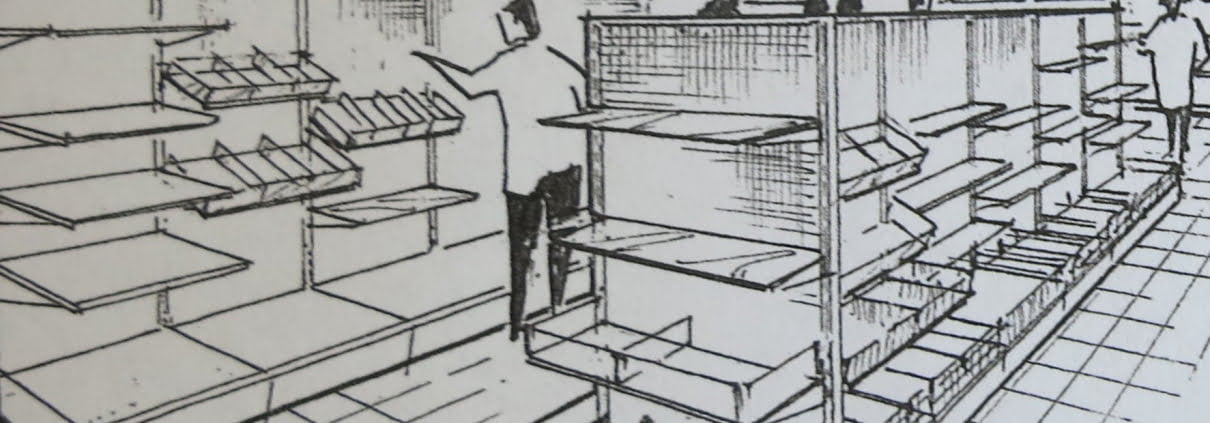The Rise of Modular Systems
The rise in self-service merchandising in the early 1950’s gave birth to modular shopfitting, and this changed the way that retail stores were to be designed and fitted out.
The requirement for a more flexible store layout led to the rapid development of slotted adjustable shelving systems. While this significant development coincided with the widespread introduction of self-selection, stripping and brackets had existed since at least the 1920s. Known as a keyhole for obvious reasons, this system was used in showcases and on back fixtures to carry glass shelving. It carried on mostly unchanged until the arrival of slotted metal systems.
In the early years, the three main promoters of this concept stuck rigidly to the specifications of their overseas manufacturers and associations. TS Gill in Melbourne were associated with the American Grand Rapids, RMS (also from Melbourne) were associated with the Weber Corporation and DH Gibson in Sydney based their product on the catalogue of Reflector Hardware. The result of this was that none of the different systems could be interchanged with each other; thus when a supplier obtained an initial order from a retailer, they were almost assured of getting any future business as to gain full advantage of interchange throughout their store, it was necessary to maintain the same product.
The retail industry readily accepted this new style of fixturing and as demand accelerated, more companies realised the potential and entered the field such as Kingfisher and Lincoln in Melbourne, Kanweld and ROR in Sydney, Bevlyn Wire (now BDS) in Brisbane and Repbrax in WA. One of the first major take ups occurred when David Jones used DH Gibson’s system in the fashion department of their Elizabeth Street, Sydney store. Woolworths also saw the advantages of the new system and trialled it in behind the counter back fixtures of their new Variety store at Eastwood NSW in 1953. As Gibsons’ business grew rapidly, the range was extended and to encourage the idea of ease of installation it was marketed under the name of U-Rect-lt (URl).
Later, other companies who enjoyed success included Shopfittings of Australia, who were major suppliers to Target and Daneline, who as well as supplying Myer also supplied a large number of shopfitters and was one of the first to provide the domestic market.
HM Cowdroy also added a range to their suite of products servicing all areas of the market, predominantly through hardware stores.
Growth in self-service food outlets attracted Steelbilt and Brownbuilt, both manufacturers of steel storage shelving, into the field. They were relatively successful, but after a few years, both companies ceased operating in this area.
Initially, wall stripping was manufactured from extruded aluminium sections, or rolled form and press-formed mild steel U-channel and welded back to back to form a box section, to make double-sided floor displays that became known as gondolas.
Through ingenious engineering techniques, several manufacturers were able to perfect the slotting of mild tube box sections, which improved the fabrication of gondolas and to broaden the scope and usage of the equipment into other applications such as wall and freestanding fixturing.
In the mid-1950’s Kanweld through its association with Grace Bros. who had various systems throughout their many stores, produced a universal bracket able to interchange with most other systems but again it had a limited life and applications.
The four leading suppliers had different pitch/gauge product:
• RMS range 25mm (1”) pitch on 12 gauge wall stripping,
• Gilflex range 25mm (1”) pitch on 15 gauge wall stripping,
• URI range 36mm (40mm) pitch on 15 gauge wall stripping
• Kingfisher range 36mm (1.5”) pitch on 14 gauge wall stripping.
During the period of the late 1950s and 1960s various companies started to manufacture floor units using slotted metal construction. At first, these tended to be static units of a fixed length, typically 1200, 1500, or 1800 with centres of 600, 750 or 900. As we can see from the drawings of units of the time, they were what we know as gondolas and dump or promotional tables. Some also incorporated storage areas either at the top or in the bottom and were sometimes grouped in ‘nests.’ Although this type of unit did provide an element of display flexibility and was a significant step towards self-service, they were not ‘truly modular.’
The success of the floor units was soon apparent, and this led to the rapid development of ‘truly modular’ systems for both floor and wall. Gondolas could be extended to any length using a suite of Meccano-like components. However, it was wall systems that were the greatest boon to retailers and shopfitters alike. Retailers could swiftly and cost effectively alter or add components to the system to suit the stock requirements, and shopfitters had an answer to out of plumb walls, un-level floors and increasingly, non-load bearing walls. In the sketches shown here, taken from a manufactures catalogue of the mid-1960’s, it can be seen that modular systems were here to stay.
Over time, systems evolved to suit a variety of purposes, the use of high gondolas with backup stock at the top in supermarkets being a good example. This made use of non- productive retail space and reduced the required area of storerooms.
The face of retailing in all areas be it department stores, pharmacy, fashion, newsagency, hardware, electrical, service stations and of course food is forever changing and with it comes some dramatic changes to the fixturing requirements and solutions to meet the new merchandising trends but incredibly most of the new systems still maintain the proven modular approach.
Modular fixturing continues to give the end user “flexibility” with the ability to change their merchandise displays at will to achieve the best possible result for seasonal or specials promotions at no cost.




Leave a Reply
Want to join the discussion?Feel free to contribute!